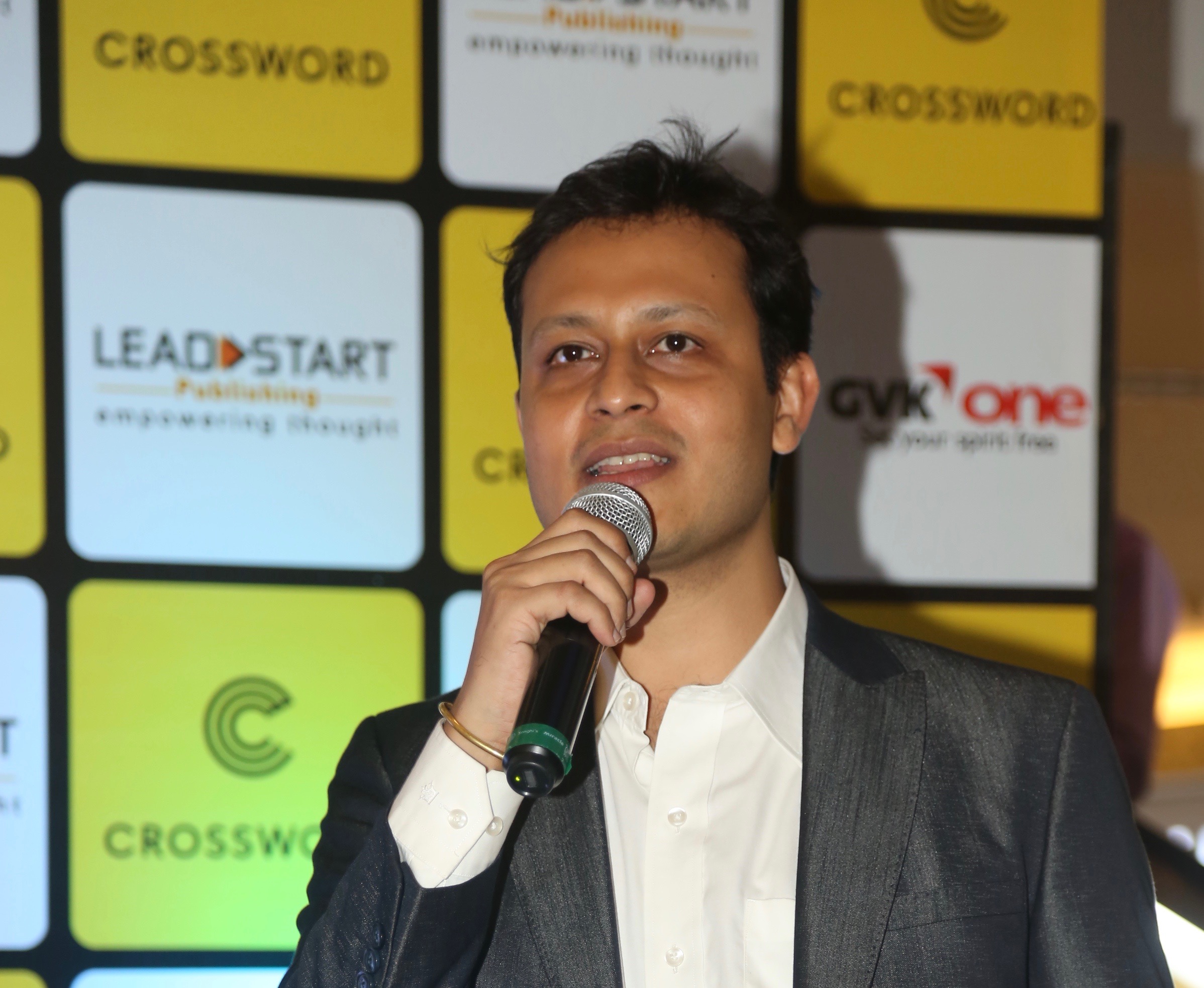
Swarup Nanda is the Chairman & CEO of Leadstart Publishing. A Mechanical Engineer with an MBA in marketing, Swarup has over a decade’s experience in multiple business domains. He is the business head of three privately-held firms working in various domains of Book Publishing, Content Creation, Angel Investing, and Business Consulting. His passion for literature and books motivates him to build greater and achievable successes for Leadstart Publishing.
When did Leadstart Publishing start and when did you come on board, and what is your role as the CEO?
Leadstart Publishing came into being in 2007; I joined the organization in 2010. My responsibilities are primarily overseeing marketing, distribution and sales.
Who are the writers that you read and admire for the craft and wish that they had published their works at Leadstart?
There are many, the list is long, I would refrain from commenting of a few in particular.
According to you what kind of books appeal to a ‘word challenged’ audience of today’s day and age?
The ‘word challenged’ audiences is an interesting issue facing the publishing industry and since the dawn of trade publishing, not just today. The term ‘word challenged’, has two different meanings and hence two different opportunities or challenges emerge as you see them, one where books using a simpler writing style (read that as less verbose) helps to widen readership and the other where limiting the number of words (and therefore pages), helps attracting readers who prefer shorter reads or don’t prefer committing too much time to a single read. The success of Mills and Boon/Harlequin is a classical case study, in which they have used oversimplified writing to their advantage for decades. The logical extension of their thought process is to use simplistic writing for popular fiction, across all sub-genres. The other part of the challenge is being dealt with in interesting ways, especially in non-fiction. The success story of ’Blinkist’, currently in a web and iOS app shows us how much people prefer a condensed read for non-fiction. The trend is exemplified by several mainstream nonfiction publishers releasing two versions of the book on the e-book formats, one which is basically the book’s condensed format and the full book at different price points. Here again, the challenge is sub-genre neutral in non-fiction.
On that same note do you think that pulp fiction is back–Game of Thrones, 50 shades of Grey are not exactly literature, yet they have appealed to readers worldwide?
Most certainly they are not literature in the classical definition, yet the point here is different. Pulp fiction has never entirely disappeared, what has possibly changed is with a flatter world, or a global village, these have become bigger phenomena than they ever were ever envisaged to be. The millennial generation has an interconnected world like never before. A significant number of teens, irrespective of where they live read the same books, watch the same TV shows, follow the same sports and listen to the same music across continents, and across the world. The flip side of the difference in sales of successful books and the ones who have lesser readership has widened way too much, so much so that they are creating monopolistic trends in consumption.
You’ve been in the business of publishing for one of the largest populations in the world. What do you think works and what don’t quite make it to press?
Great writing is always in demand, but what goes to the press is nowhere a measure of the success of the book, if accomplishment merely equals to a lot of the general public reading the book. India is just warming up to trade publishing. Most reading in India is academic and reading for leisure is not really a part of popular culture. Since most people read very few books each year, they invariably opt for the bestsellers.
Chetan Bhagat is one of India’s most widely read authors in India, and by South Asians globally and each week when I see the Neilsen BookScan report I find his first book which is almost a decade old now appear on the charts regularly. If one assumes the same person is not repurchasing the same book, what it tells us for sure is that the book is finding new readers.
There are quite clearly two models here; the blockbuster model and the long-tail model. The same is the case with publishing globally now, a handful books and authors are selling in millions and the others are struggling to get through a few hundreds while ironically millions of books are still getting published every year. Please note that the sales have almost no connectivity to the quality of the book, which is the disheartening part.
It’s a misnomer that an author makes millions. For the benefit of future writers can you make the journey realistic for them?
That is true for everyone in every field, not just authors, whether you are an artist, or work for a corporation—there will always be the superstars—leaders, CEOs, and then there is everyone else. The good news is with the internet, social media and an interconnected world, spreading the word is much faster than ever before.
E-commerce (for both e-books and paperbacks) plays both angel and devil together, discovering newer books , especially in fiction is very difficult on e-commerce, but it opens the world market for each author and the books are available round-the-clock. Also, the dependence on the space a physical bookstore can give a book is no longer a limitation. So you have a level playing field on availability and access to markets, books don’t have an expiry date which gives authors the time to build themselves as a brand to keep trying to hit the bull’s-eye.
Have Leadstart published any authors who’ve made it to the bestseller lists? Have you encouraged and mentored any prima donnas in literature?
Several Leadstart authors have made it to bestseller lists, have been nominated and won several awards and play a prominent part on the bestseller lists. This year we have an exciting lineup and hope to see more of our authors making it to the bestseller lists. Among a few names, Anand Neelkantan, Anuja Chandramoili, Sharad Nalawade, Luke Coutinho, Abhijit Basu come to mind who have created a dent on the bestseller lists with their very first books which were published by us.
Talk to us about the great writer + agent collaboration. In your opinion can this relationship last a lifetime? What are the pros and cons?
A great writer + agent collaboration is a difficult relationship to have for a lifetime, invariably one of the partners either the writer or the agent outgrows the other and for the right reasons, it is best to move on.
According to you is the future of reading going to be e-books? How financially and business savvy will this model be?
Well, globally it seemed so for the last few years until it plateaued and paperbacks came back strongly. The model is financially great for both publishers and writers, but is plagued by digital piracy like all other digital media. You can almost get any bestselling title on a torrent site somewhere. Controlling piracy is the challenge; that being said the model can otherwise deliver limitless opportunities.
How does this e-driven future look for Leadstart?
It looks great. There are two components of the same, several e-commerce companies in India got a lot of funding post-2009, a lot of that investor money got discounted deals for book buyers and the paperback sales via e-commerce sky rocketed. The other part are of those the e-books, the numbers of which have been climbing up year on year. More e-book retailers are coming in and the existing ones like Kindle are making a lot of investments in markets like India fueling that strategic growth.
At the risk of putting yourself in the defensive, what do you think works best: selling your book to a publisher, or self-publishing?
From an author’s perspective one needs to understand, self-publishing and traditional publishing are two different business and have different merits. It depends on what you have written and what are your objectives, or wants out of the book. Before pitching to a traditional publisher it’s good to do your homework and visit a bookstore, just to see if the genre of the book is available in the store, see if the word count / number of pages match the ones in the bookstore, in short analyze your book’s strengths. Traditional publishers will never back anything which in not ‘commercial’ in nature. Many rejections happen for authors just because they have either pitched it to a publisher who is just not familiar with the genre, or the book does not merit being a marketable or saleable product. Let’s say for example you have written a 10k word book, many traditional publishers would reject it even without looking into it. While the same title might end up becoming an excellent self-published e-book. If the book fits an affirmation and a commercial product’s description, and pecuniary incentive is a criterion, traditional publishing is hands down the best option. Everything else probably falls into the self-publishing option.
Jude Paul Fernandes / jude@thesouthasiannews.com


 South Asian News E-Paper
South Asian News E-Paper Punjabi News E-Paper
Punjabi News E-Paper

















